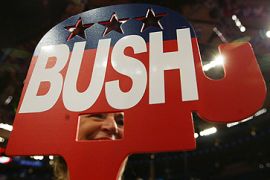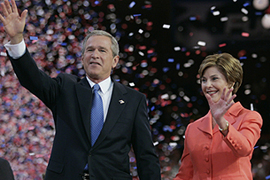Profile: The Republican Party
Al Jazeera profiles the US Republican Party.

 |
| Republicans are hoping for another four years in power [EPA] |
The Republican Party, or “Grand Old Party”, as it is affectionately known, is the second oldest political party in the United States.
It has given the country some of its most illustrious presidents, most notably Abraham Lincoln, who presided over one of the US’s most traumatic and tumultuous periods in history in the 19th century.
However, as the party prepares next year to select its candidate for the 2008 presidency, it finds itself at a crossroads, with many feeling that the party needs to redefine itself after eight years under the Bush administration.
Should it return to power, the the Republican will also once again set the agenda for the nation’s foreign policy, which will be closely watched by the international community as tensions with Iran over its nuclear programme continue and a solid resolution to the Israeli-Palestinian conflict remains difficult.
Radical beginnings
| In focus |
The party itself was founded in 1854 by members of the nation’s Free Soil, Whig and Democratic parties, who had been left disillusioned by the ongoing political battles within the US over slavery.
The final straw had been the controversial Kansas-Nebraska act, which allowed territories to determine for themselves whether they could legalise slavery.
Exploiting the turmoil created by the act, Democrat Alvan E Bovay united those disillusioned members under the banner of the new Republican Party.
The party chose its name, according to the party’s website, because it was “simple, synonymous with equality and alluded to the earlier party of [third US president] Thomas Jefferson, the Democratic-Republicans”, the party’s website says.
More unusually, its symbol – an elephant – dates from a cartoon by Harper’s Bazaar magazine which used the animal as the party’s symbol, while the Democrats were depicted even more unfortunately as a donkey.
Its first convention was held in July 1854 and its first presidential candidate, John C Fremont, ran for the presidency (unsuccessfully) in 1856.
Only four years later, Abraham Lincoln won the presidency for the party and entered the White House. The year after he entered office, the civil war erupted.
Republican candidates continued to dominate the US political scene throughout the post-civil war reconstruction era and the late 1800’s, but the party was increasingly forced to dilute its position in order to maintain power and became more aligned with big business interests.
Rise of Christian right
Following the 1929 Wall Street economic crash and ensuing Great Depression of the 1930s the country shifted to the left and the Republican party’s conservatism proved out of step with voters.
But the perceived threat of communism following the end of World War II led to the party’s resurgence and the election of General Dwight D Eisenhower on a pledge of combating the threat and lowering taxes.
The 1960’s saw a slow but significant shift of power to the more conservative wing of the party, and also a shift in its geographic strongholds – the party once seen as a bastion of the north was fast becoming the favoured party of the south.
By the 1980’s the party’s power reached its zenith under Ronald Reagan, whose eight-year term defined the decade and led to the rise of the Christian right, many of whom supported Regan and galvanised voters in favour of the Republicans.
Following Bill Clinton’s eight-year term, voters returned the Republican party to office in a hotly disputed and bitterly fought contest which ended in the election of George Bush to office.
Bush’s foreign policy advisors have since set a foreign policy noted for its hawkishness and for the doctrine of pre-emption.
From isolationist to interventionist
 |
| Bush’s legacy will define the next moves of the Republican party [EPA] |
As Bush prepares to leave office following some of the most contentious and divisive years in US politics, the nation is preparing for an election where both parties and candidates are being scrutinised for their foreign policy as never before.
Before World War II, the Republican party’s foreign policy was defined by isolationism – a desire to stay out the turmoil that engulfed Europe in the first part of the century.
It took the perceived threat of communism and threats to US business interests to alter this ideology.
During the the late 1960’s and early 1970’s Republican foreign policy was dominated by the figure of Henry Kissinger, whose policy of ‘realpolitik’ led to the US supporting a range of military and un-democratic governments in an attempt to counter the threat of the Soviet Union.
In the 1980’s defence spending increased massively under Ronald Reagan, although the former actor did achieve a landmark nuclear weapons agreement with Mikhail Gorbachev, the former Soviet leader.
With the party out of power during the Clinton administration of the 1990’s, the neo-conservatives, a group of intellectuals who called for the US to use its military power to bring democracy and US values across the globe.
This transformational ideology was fully unleashed following the 11 September 2001 attacks, with Republican leaders promising to bring democracy to the Middle East by toppling the Iraqi government of Saddam Hussein.
Life after Bush
However, the party has suffered from the ongoing violence in Iraq – and was punished by voters in the US mid-terms, who handed the Senate back to the Democrats.
The party has also been hit by several sex scandals that have tarnished its image as the party of family values and its strong stance on immigration has hurt its image amongst ethnic voters.
Now, the choice of candidate will prove crucial to the party in signalling to prospective voters and die-hard Republicans the party’s next move.
It remains to be seen whether it will adopt a more conciliatory approach in foreign policy or continue the hawkish programme of the Bush administration.
